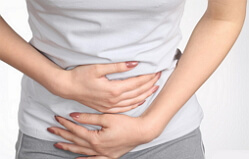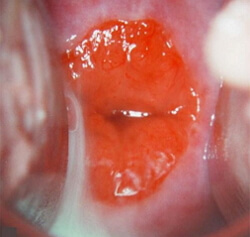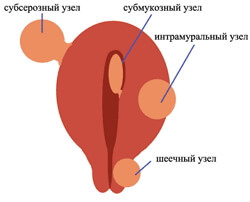Pelvioperitonitis
 Pelvioperitonitis is an inflammation of the pelvic peritoneum, which often develops against the background of an infectious inflammatory process in the pelvic organs. Among the "culprits" of inflammation with pelvioperitonitis are more frequent microbial associations, consisting of aerobic and anaerobic microflora, chlamydia, mycoplasmas. Specific inflammation of the pelvic peritoneum( gonorrheal pelvioperitonitis) is less common.
Pelvioperitonitis is an inflammation of the pelvic peritoneum, which often develops against the background of an infectious inflammatory process in the pelvic organs. Among the "culprits" of inflammation with pelvioperitonitis are more frequent microbial associations, consisting of aerobic and anaerobic microflora, chlamydia, mycoplasmas. Specific inflammation of the pelvic peritoneum( gonorrheal pelvioperitonitis) is less common.
Pelvioperitonitis, regardless of the form of the course of the inflammatory process and its cause, always begins with the penetration of the source of inflammation into the pelvic cavity, namely, the peritoneum. The peritoneum is a dense serous membrane located inside the abdominal cavity. Outwardly, it resembles a thin translucent film with a shiny surface that not only covers the inside of the abdominal wall( parietal leaf), but also "wraps" the internal organs( visceral leaf) inside it. The peritoneum is not interrupted anywhere, therefore it is similar to a bag, its total area reaches almost 1,5 sq.m. Parietal and visceral leaflets of the peritoneum do not close, but form a slit-like space called the cavity of the peritoneum; there is always a small amount of serous fluid in it, which has a bactericidal effect.
Passing from the walls of the abdominal cavity to the organs located in it, the peritoneum forms numerous folds, pockets, bags and other indentations. Smooth, constantly moist surface of the peritoneum provides a smooth gliding of the internal organs, and also protects them from negative influences.
Inflammatory process of the peritoneum due to infection with pathogenic microbes is called peritonitis. It has a widespread( diffuse) form and proceeds very hard, provoking serious septic effects.
Pelvic peritonitis develops when the pelvic peritoneum is infected. The pelvic peritoneum delimits the small pelvis from the rest of the abdominal cavity, therefore the inflammatory process with pelvioperitonitis is also local and proceeds more favorably.
Symptoms of pelvioperitonitis correspond to the clinical picture of acute infectious inflammation. All diagnostic and treatment activities are carried out after the preliminary hospitalization of the patient.
Pelvioperitonitis in gynecology is treated in accordance with the principles of therapy of acute infectious processes, therefore the main method is adequate antibiotic therapy.
Causes of pelvic peritonitis
Primary pelvioperitonitis begins to form after direct penetration of the pathogen into the pelvic cavity. However, secondary pelvioperitonitis is more common, when the infection on the pelvic peritoneum comes from already existing adjacent foci of infectious inflammation: from the fallopian tubes, ovaries, uterus.
To predisposing negative factors of inflammation of pelvic peritoneum are:
- perforation( damage to the wall) of the uterus during abortion or diagnostic curettage;
- hydro- and perturbation of fallopian tubes( "blowing");
- introduction into the uterine cavity of aggressive chemical substances by the woman herself with the purpose of criminal interruption of unwanted pregnancy or in the process of diagnostic gynecological manipulations;
- damage to the posterior vaginal arch during surgery;
- metrosalpingography;
- salpingitis, salpingoophoritis, metroendometritis;
- specific sexual infections( gonorrhea);
- tuberculosis of any site;
- acute appendicitis( especially complicated).
Separately it is necessary to note a pelvioperitonitis, sometimes found in obstetric practice. In the vast majority of cases, it is diagnosed after cesarean section in women with endometriometritis and unsuccessful sutures on the uterine wall. Although the frequency of occurrence of this pathology is low( 0.05% - 0.3%), it is obstetric peritonitis that differs in the most severe course, since infectious inflammation, initially having a delimited character( pelvioperitonitis), spreads quickly beyond the pelvic region and is transformed into a vastInflammation of the peritoneum( peritonitis).
An important factor in the development of inflammatory processes of the pelvic cavity is the state of immunity. Peritone performs not only the functions of mechanical protection of the abdominal cavity, the serous fluid secreted by it has the ability to absorb and destroy undesirable microorganisms, that is, in fact, a biological barrier. In a healthy organism, the serous cavity is always sterile, but if the immune system does not cope with its basic tasks, the infection that has penetrated into the pelvic cavity can provoke a pathological process. That is why pelvioperitonitis in gynecology always develops against the background of ailments that deplete the mechanisms of immune defense.
Symptoms and signs of pelvic peritonitis
The likelihood of pelvic inflammatory pelvic inflammation increases significantly after abortion, traumatic birth or due to caesarean section. Also, the infection in the peritoneal cavity can penetrate from the inflamed uterine appendages, especially after the breakthrough of purulent formations localized in them. In metroendometry, the lymphogenous pathway of infection is most likely, and a specific inflammation( with gonorrhea) usually "rises" into the pelvic cavity through the fallopian tubes.
The presence of infection in the peritoneal cavity provokes increased secretion of the inflammatory fluid - exudate. Its nature depends on the source of the infection. Exudate can be serous, purulent, fibrinous( when there is a lot of protein, fibrin in the inflammatory secret) or mixed( serous-purulent).According to the nature of the exudate, serous, fibrinous and purulent pelvioperitonitis is secreted. Purulent pelvioperitonitis is more often provoked by pathogens of gonorrhea( gonococci).
The disease always begins with an acute stage. In the serous or fibrinous nature of inflammation, a microcirculation disorder occurs, a pronounced local inflammatory edema appears. In the cavity of the peritoneum, serous exudate begins to accumulate, in it there may be filaments of fibrin, leukocytes, albumin. Soon the processes of dystrophy of the serous cover are "launched".
Then the acute process subsides, the inflammatory exudate becomes thick, adhesive, that is, in fact, forms spikes. Between the spikes can form closed cavities filled with serous fluid. Inflammation of the pelvic peritoneum, accompanied by an extensive adhesive process, is classified as an adhesive pelvioperitonitis.
Gonorrheal pelvioperitonitis is distinguished by a more eroded and slow course, as the inflammation is quickly delimited, and purulent exudate accumulates in the space between the uterus and rectum( abscess of the Douglas space).Such purulent abscesses can break into any adjacent area or organ.
The onset of pelvioperitonitis is accompanied by symptoms of an acute infectious process. There is a sharp pain in the lower segments of the abdomen, a marked fever( sometimes up to 40 ° C), tachycardia, weakness. As the inflammation worsens, vomiting, bloating, urination and defecation are added to the clinic of the disease. Acute pelvioperitonitis clinically resembles an acute surgical pathology with a typical clinic of an "acute abdomen".
After two days the inflammatory process reaches a clinical peak, and then stabilizes. Patients indicate improvement in the general condition, but in reality the infectious process does not disappear, but only becomes more local.
Pelvioperitonitis is characterized by a protracted course, when the beginning of the improvement suddenly gives way to exacerbation of the infectious process. If acute pelvioperitonitis does not stop in a timely manner, in the place of accumulation of inflammatory effusion( exudate) begins to form adhesive chronic pelvioperitonitis. Spikes lead to a change in the normal topography of the pelvic organs and provoke chronic pelvic pain.
Nonspecific chronic pelvic peritonitis is considered secondary if it is formed as a complication of an acute process. The primary chronic inflammation of the pelvic peritoneum is said to be caused by the persistent effect on the peritoneum of a weakly virulent infection.
Pelvioperitonitis, provoked by Chlamydia infection, can occur atypically: the symptoms grow gradually, can be expressed slightly, there is a tendency to form adhesions.
Pelvioperitonitis is a delimited process, therefore infrequently provokes the spread of the infection to the entire peritoneum and, as a consequence, severe septic effects.
However, untimely diagnosed and treated inflammation can lead to impaired reproductive function. Adhesive pelvioperitonitis provokes female infertility due to the expressed adhesion process.
Diagnosis of pelvic peritonitis
It is possible to suspect the presence of inflammation in the pelvic peritoneum already during the initial examination. It also helps in the diagnosis of carefully collected history, because often patients indicate the presence of chronic gynecological ailments( salpingitis, endometritis, salpingo-oophoritis) and associate their condition with their exacerbation.
Gynecologic examination provokes severe pain, especially when trying to dislocate the cervix. Accumulated in the posterior fornix inflammatory exudate is visualized as a protrusion of the vaginal wall, and the palpation of this zone is sharply painful. The contours of the uterus are not clearly defined, and the appendages are often thickened and also painful.
The analysis of blood ascertains the presence of acute inflammation: increased ESR, the number of leukocytes exceeds the norm, and the parameters of the leukocyte formula are shifted to the left.
Ultrasonic scanning of the pelvic cavity helps to see free fluid, a change in the topography of the pelvic organs.
It is not enough to establish the presence of pelvioperitonitis for successful treatment. It is necessary to find out its origin, that is, determine the nature of the infection. Since most pelvioperitonitis develop due to ascending infection, diagnostic measures necessarily include the study of the composition of the vaginal microflora. It should be borne in mind that the composition of the vaginal microflora coincides with that in the fallopian tubes and pelvic cavity by only 50%, and the most reliable is the direct investigation of the microbial composition of the inflammatory exudate. It can be obtained by puncture of the posterior vaginal arch or laparoscopy( carried out only according to indications).
The picture of pelvic peritonitis is not always clear, in case of doubt, laparoscopy is performed.
Treatment of pelvic peritonitis
The treatment program for pelvic peritonitis is consistent with the rules for the treatment of acute infectious inflammatory processes of the pelvis. The reason for immediate hospitalization are acute onset of the disease, severe pain syndrome, signs of intoxication and irritation of the peritoneum.
Treatment is worth starting immediately, to delimit the infectious process and prevent unwanted septic effects.
The basis of the therapy is antibiotic therapy. An antibiotic with the widest possible spectrum of effects is chosen, since most pelvioperitonitis is provoked by microbial associations, and not by a single pathogen. Often an optimal combination of antibiotics belonging to different groups is used. There are no universal antibiotic treatment regimens; when choosing the necessary drug, the physician relies on the results of a laboratory study. In parallel, elimination of intoxication, pain relief, vitamin therapy is carried out.
Pelvioperitonitis, like any infectious process, severely depletes the immune system, so immunostimulating agents are always included in the list of medications.
Uncomplicated pelvioperitonitis, provided that adequate and timely treatment is started, is relatively fast, and therefore belongs to the category of diseases with a favorable outcome for life. However, the patients cured of this disease have a high risk of developing post-infection complications: adhesions and infertility. To prevent the negative consequences in the next stages of treatment, resorption therapy and normalization of the hormonal function of the ovaries are carried out. Unfortunately, it is not always possible to prevent damage to the reproductive function after the carried pelviperitonitis.



